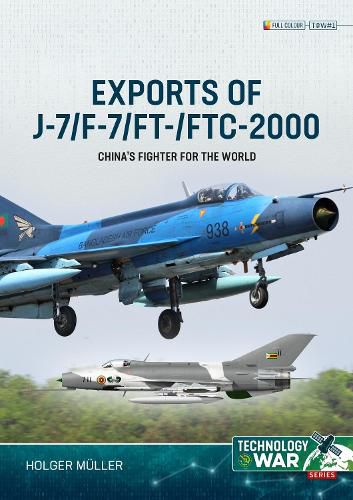Readings Newsletter
Become a Readings Member to make your shopping experience even easier.
Sign in or sign up for free!
You’re not far away from qualifying for FREE standard shipping within Australia
You’ve qualified for FREE standard shipping within Australia
The cart is loading…






When it was founded in 1949, the People's Republic of China was a backward agricultural state with no industrial base to speak of and no armaments industry of its own. From the very beginning, Mao Tse Dng, the founder of the state, endeavoured to develop his own modern defence industry in order to gain weight on the international stage. Part of this effort was the development of a domestic aerospace industry with massive support from the Union of Soviet Socialist Republics (USSR, colloquially 'Soviet Union'). Until the two countries broke up in 1961 due to ideological differences, more than 100 aviation companies were established with Soviet help and the licensed production of numerous aircraft types from trainers to heavy bombers was started. The last of these was the MiG-21, which is reproduced in China as the J-7. It took more than 10 years before the country, weakened by the 'Great Leap Forward' and the Cultural Revolution, succeeded at all in producing this comparatively complex aircraft. Only the comprehensive reforms after the death of state founder Mao created the basis for a return to orderly production of a technology that was already two decades old and outdated. The rapprochement with the West in the early 1980s made it possible, in part, to overcome the technological backlog. The integration of Western avionics into the Soviet airframe did not make the J/F-7 a modern combat aircraft like the F-16 and MiG-29 developed at the same time, but it increased its combat value to such an extent that it became an export success for the Third World. However, even more important was the access to Western technologies, later also for air-to-air missiles, which were initially, simply copied and later formed the basis for in-house developments of modern equipment and weapons systems. When cooperation with the West ended abruptly after the Tiananmen massacre of 1989, Chinese engineers and scientists had accumulated enough know-how to provide their own impetus in the further development of the J/F-7 family. Due to the combination of new aerodynamics and modern avionics, true multi-role combat aircraft were finally created which today, still spearhead their air forces in numerous countries in Asia and Africa. When the production of the J/F-7 finally ended in 2016, two generations of modern fighters based on this design were coming off the production line in China, and the prototypes of the fifth generation were already flying. The experience gained by China's aerospace industry in developing the J/F-7 from a day fighter to a multi-role fighter has made this success possible. The book deals with both the technical development of the J/F-7 family and its actual or potential use in more than a dozen countries on five continents. 220-240 colour photos, 1 map, 20 colour profiles, 1 table
$9.00 standard shipping within Australia
FREE standard shipping within Australia for orders over $100.00
Express & International shipping calculated at checkout
When it was founded in 1949, the People's Republic of China was a backward agricultural state with no industrial base to speak of and no armaments industry of its own. From the very beginning, Mao Tse Dng, the founder of the state, endeavoured to develop his own modern defence industry in order to gain weight on the international stage. Part of this effort was the development of a domestic aerospace industry with massive support from the Union of Soviet Socialist Republics (USSR, colloquially 'Soviet Union'). Until the two countries broke up in 1961 due to ideological differences, more than 100 aviation companies were established with Soviet help and the licensed production of numerous aircraft types from trainers to heavy bombers was started. The last of these was the MiG-21, which is reproduced in China as the J-7. It took more than 10 years before the country, weakened by the 'Great Leap Forward' and the Cultural Revolution, succeeded at all in producing this comparatively complex aircraft. Only the comprehensive reforms after the death of state founder Mao created the basis for a return to orderly production of a technology that was already two decades old and outdated. The rapprochement with the West in the early 1980s made it possible, in part, to overcome the technological backlog. The integration of Western avionics into the Soviet airframe did not make the J/F-7 a modern combat aircraft like the F-16 and MiG-29 developed at the same time, but it increased its combat value to such an extent that it became an export success for the Third World. However, even more important was the access to Western technologies, later also for air-to-air missiles, which were initially, simply copied and later formed the basis for in-house developments of modern equipment and weapons systems. When cooperation with the West ended abruptly after the Tiananmen massacre of 1989, Chinese engineers and scientists had accumulated enough know-how to provide their own impetus in the further development of the J/F-7 family. Due to the combination of new aerodynamics and modern avionics, true multi-role combat aircraft were finally created which today, still spearhead their air forces in numerous countries in Asia and Africa. When the production of the J/F-7 finally ended in 2016, two generations of modern fighters based on this design were coming off the production line in China, and the prototypes of the fifth generation were already flying. The experience gained by China's aerospace industry in developing the J/F-7 from a day fighter to a multi-role fighter has made this success possible. The book deals with both the technical development of the J/F-7 family and its actual or potential use in more than a dozen countries on five continents. 220-240 colour photos, 1 map, 20 colour profiles, 1 table